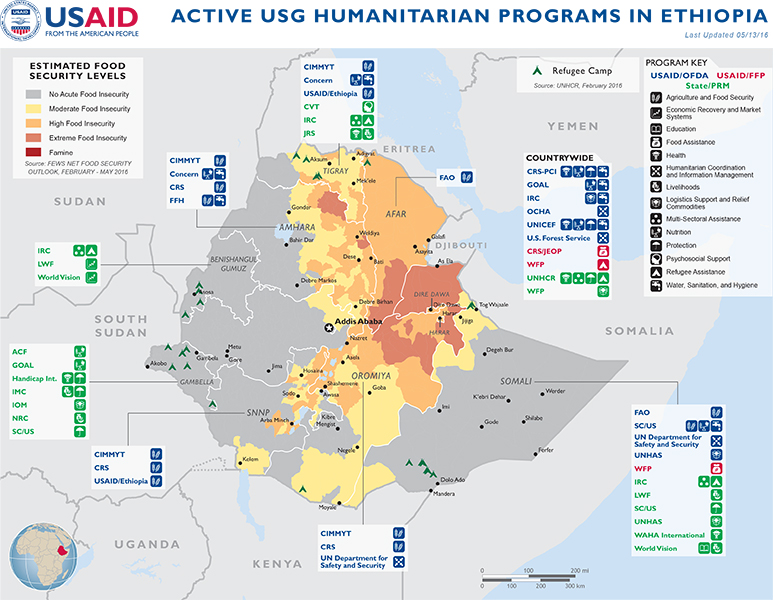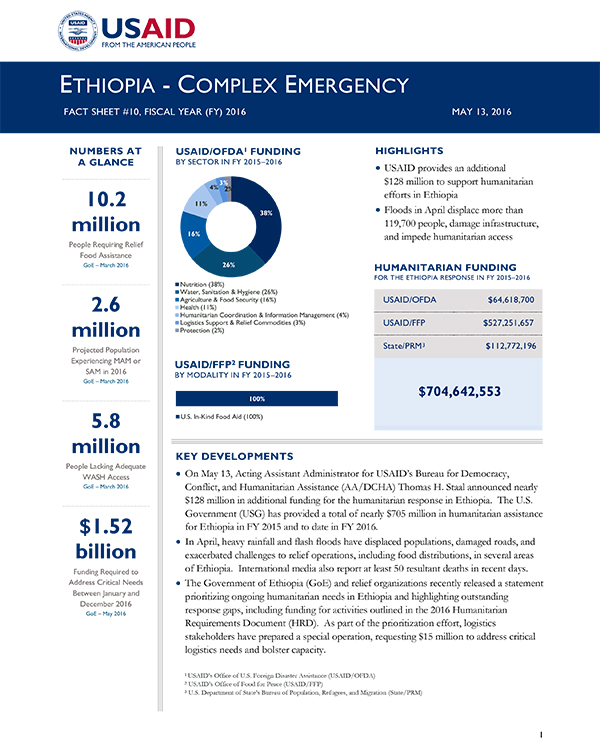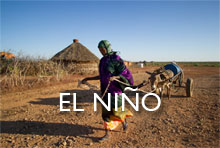- What We Do
- Agriculture and Food Security
- Democracy, Human Rights and Governance
- Economic Growth and Trade
- Education
- Ending Extreme Poverty
- Environment and Global Climate Change
- Gender Equality and Women's Empowerment
- Global Health
- Water and Sanitation
- Working in Crises and Conflict
- Disaster Assistance
- Political Transition Initiatives
- Conflict Mitigation and Prevention
- Countering Violent Extremism
- Disaster Risk Reduction
- Peacebuilding and Reconciliation
- Providing Safe & Secure Environments for Development
- Recovering From Crisis
- Resilience
- Tech Challenge for Atrocity Prevention
- World Humanitarian Day
- U.S. Global Development Lab
May 13, 2016
Highlights
USAID provides an additional $128 million to support humanitarian efforts in Ethiopia
Floods in April displace more than 119,700 people, damage infrastructure, and impede humanitarian access
Key Developments
Ethiopia Map - 05-13-2016 ![]() (pdf - 786k)
(pdf - 786k)
Numbers At A Glance
10.2 million
2.6 million
5.8 million
$1.52 billion
Humanitarian Funding
For the Ethiopia Response
FY 2015 - 2016
| USAID/OFDA | $64,618,700 |
| USAID/FFP | $527,251,657 |
| State/PRM | $112,772,196 |
| TOTAL | $704,642,553 |
On May 13, Acting Assistant Administrator for USAID’s Bureau for Democracy, Conflict, and Humanitarian Assistance (AA/DCHA) Thomas H. Staal announced nearly $128 million in additional funding for the humanitarian response in Ethiopia. The U.S. Government (USG) has provided a total of nearly $705 million in humanitarian assistance for Ethiopia in FY 2015 and to date in FY 2016.
In April, heavy rainfall and flash floods have displaced populations, damaged roads, and exacerbated challenges to relief operations, including food distributions, in several areas of Ethiopia. International media also report at least 50 resultant deaths in recent days.
The Government of Ethiopia (GoE) and relief organizations recently released a statement prioritizing ongoing humanitarian needs in Ethiopia and highlighting outstanding response gaps, including funding for activities outlined in the 2016 Humanitarian Requirements Document (HRD). As part of the prioritization effort, logistics stakeholders have prepared a special operation, requesting $15 million to address critical logistics needs and bolster capacity.
CURRENT EVENTS
On May 10, the GoE and relief organizations released a prioritization statement, underscoring acute relief needs and critical response activities, including new and unfunded interventions from the 2016 HRD. The statement indicates that an additional $702.6 million is urgently required to address priority needs through December; donors had contributed approximately 65 percent of the original $1.4 billion HRD appeal as of early May, according to the UN. An HRD revision is expected in late June following a GoE-led, interagency assessment evaluating humanitarian needs and the success of the harvest following the February-to-June belg season.
Acting AA/DCHA Staal visited Ethiopia from May 8–13 to meet with key GoE officials, international donors, the USAID Disaster Assistance Response Team (DART), USAID/Ethiopia personnel, and relief organizations. Acting AA/DCHA Staal and the DART also traveled to drought-affected areas of Afar and Oromiya regions to evaluate humanitarian conditions and assess USAID-supported humanitarian interventions, including a relief food distribution in eastern Oromiya’s Mieso woreda, or district, under the USAID/FFP-funded, Catholic Relief Services (CRS)-led Joint Emergency Operation (JEOP). In March, the GoE classified Mieso as a priority one hotspot district, as more than 147,000 people—approximately 90 percent of the district—were receiving either JEOP relief food assistance or cash and food assistance under the GoE-led Productive Safety Net Program.
Heavy rainfall have generated flash floods in parts of Afar, Amhara, Dire Dawa, Harari, Oromiya, Somali, Tigray, and Southern Nations, Nationalities, and Peoples (SNNP) regions since late March, damaging roads and exacerbating delays in the dispatch and distribution of relief food assistance, particularly in Somali, where flood damage prevented access to some final distribution points, according to the UN. The International Organization for Migration (IOM) reports that flooding displaced nearly 19,600 households—more than 119,700 people, including approximately 89,900 people in Somali—during April. International media report that heavy rainfall recently caused landslides in SNNP’s Wolayita Zone, resulting in at least 41 deaths; flooding has resulted in an additional nine deaths in Oromiya’s Bale Zone.
An interagency assessment team—comprising GoE, UN, and relief organization personnel—traveled to three flood-affected districts of Somali’s Shabelle Zone from May 4–9. The assessment found that recent flooding had destroyed more than 2,400 houses, damaged critical infrastructure and agricultural areas, and affected at least 145,000 people—with more than 64,700 people displaced in the zone; flooding also resulted in at least 2,700 livestock deaths in Shabelle’s Kalafo district. Priority needs among displaced households include emergency shelter assistance and relief items, such as mosquito nets, water purification chemicals, and other hygiene commodities.
The GoE National Disaster Risk Management Commission (NDRMC) recently activated a Flood Task Force—comprising GoE representatives and relief actors—to increase awareness of flood risks and mobilize flood-related response efforts. The GoE has supported prevention efforts in flood-prone areas and issued flood alert warnings to at-risk districts and communities. In early May, the GoE and relief organizations released a contingency plan for the 2016 belg rains to support preparedness and mitigation efforts to prevent adverse flood-related impacts. The GoE estimates that belg-related flooding could potentially affect more than 485,600 people, particularly in Afar, Somali, and Tigray.
Humanitarian actors have supported immediate rescue efforts for flood-affected populations and promoted flood awareness and preparedness in affected areas. USAID/FFP partner the UN World Food Program (WFP) deployed nine heavy trucks to Somali in early May, enabling distributions of relief food and other assistance in areas inaccessible to standard trucks due to floods. In addition, local GoE officials in Kalafo distributed approximately 1,700 plastic sheets to affected households, and IOM, the Ethiopian Red Cross Society, and Save the Children (SC) are distributing emergency shelter and relief item kits to households in Oromiya and Somali, according to the UN Office for the Coordination of Humanitarian Affairs (OCHA).
FOOD SECURITY
Recent USAID-funded Famine Early Warning Systems Network (FEWS NET) projections indicate that despite intermittent and below-average belg rainfall in February and March, intense rains during April replenished water sources and supported some pasture regeneration in drought-affected areas. Overall, national belg agricultural production is expected to be average to slightly below-average, according to FEWS NET. While poor February and March rainfall delayed planting activities in SNNP, a normal belg harvest—likely delayed by up to three weeks—is expected in most of the region. FEWS NET also reported that average belg agricultural production will likely improve food access in June for populations in the belg-producing areas of Amhara and central Oromiya. However, inadequate February and March rainfall negatively affected replanting and crop growth in some areas of southern Tigray, while poor rains in eastern Oromiya’s East Hararghe and West Hararghe zones prevented planting for most farmers.
According to FEWS NET, the June-to-September kiremt rains are expected to be average to above-average across much of Ethiopia; the kiremt rains are critical for meher crop production, especially in drought-affected areas, between June and August. Although much of Ethiopia generally experiences a multi-week gap between the belg and kiremt rains, FEWS NET has noted the possibility that ongoing belg rains could merge with the pending kiremt rains. Enhanced seasonal rainfall is likely across much of central, eastern, northern, and southern Ethiopia over the coming months.
As of April 27, the GoE and relief organizations had distributed approximately 90 percent of the first round of 2016 relief food assistance that began in late January. While the GoE and other organizations had dispatched approximately 90 percent and 41 percent of the second and third rounds of relief food assistance as of April 27, only 59 percent and 5 percent, respectively, of the two rounds have reached beneficiaries to date, according to WFP. Limited capacities at the district-, community-, and food distribution point-levels are an inhibiting factor in the significant lag between food dispatches and distributions. To facilitate relief food distributions, the Logistics Cluster—the coordinating body for humanitarian logistics activities, comprising UN agencies, non-governmental organizations (NGOs), and other stakeholders—has launched a special operation, appealing for $15 million to augment GoE distribution capacity. According to WFP, the fourth and fifth rounds of distributions will likely commence in May and June.
To date in FY 2016, USAID/FFP has provided 532,610 metric tons (MT) of food assistance valued at approximately $279.5 million to JEOP, which provides relief food assistance to approximately 2.8 million people in 76 districts. Led by CRS, JEOP is implemented by a consortium of NGOs, including CARE, Food for the Hungry (FFH)/Ethiopia, Hararghe Catholic Secretariat, Meki Catholic Secretariat, Relief Society of Tigray, SC/US, and World Vision.
While USAID/FFP primarily addresses food-related needs in Ethiopia through JEOP, USAID/FFP supports WFP to deliver relief food assistance to populations in Somali Region. USAID recently provided 27,430 MT of in-kind food assistance valued at approximately $16.2 million to support 1.5 million people, bringing USAID’s total FY 2016 relief contribution for WFP activities in Somali to an estimated $58.4 million.
According to the Office of the UN High Commissioner for Refugees (UNHCR), Ethiopia hosts the largest refugee population in Africa, approximately 705,000 people. USAID/FFP recently provided WFP with 29,410 MT of food assistance—valued at approximately $21.7 million—to support refugees, including from Eritrea, Somalia, and South Sudan.
AGRICULTURE AND LIVESTOCK
In early May, USAID/OFDA partner the UN Food and Agriculture Organization (FAO) reported key findings from a recent livestock assessment, which reviewed the impact of ongoing humanitarian assistance, identified key response gaps, and developed recommendations for priority actions to address critical humanitarian needs in drought-affected areas of Ethiopia. According to FAO, more than 1.3 million households across Ethiopia require emergency livestock support, and the UN agency is calling for more than $30.1 million to support populations in need. Afar and Somali are the most affected, as more than 808,800 households in the regions require approximately $18.5 million in emergency livestock assistance; an additional 494,500 households in Amhara, Oromiya, Tigray, and SNNP require $11.6 million.
In Afar and Somali, extended drought conditions and livestock losses—up to 80 percent for some pastoral households—have reduced milk production, decreased livestock terms of trade, and prompted population and livestock migration in search of pasture, FAO reports.
FAO has called for robust and timely interventions, given that supporting livestock health and forage seed is significantly less expensive compared to delivering emergency feed or supporting restocking. Ensuring the survival and productivity of livestock, especially in pastoral areas, is critical to improving food security, livelihoods, and nutrition conditions throughout 2016 and beyond. USAID/OFDA has provided $700,000 in FY 2016 funding to support FAO relief activities in Ethiopia.
HEALTH, NUTRITION, AND WASH
USAID/OFDA and USAID/Ethiopia recently provided the UN Children’s Fund (UNICEF) with more than $14.7 million to bolster health, nutrition, child protection, and water, sanitation, and hygiene (WASH) interventions for up to 1.8 million people across Ethiopia. USAID/OFDA is providing UNICEF with nearly $11 million to support critical nutrition activities, including community engagement, detection of acute malnutrition cases, and treatment services for severe acute malnutrition (SAM) cases. Through UNICEF, USAID is strengthening responses to drought-exacerbated diseases such as measles, scabies, and meningitis; vaccination efforts; case management; and health promotion. UNICEF is rehabilitating WASH infrastructure and expanding access to water points in drought-affected areas through increased water trucking and other efforts. Additionally, USAID/Ethiopia has contributed nearly $3.8 million to bolster several response interventions include improving existing water points and expanding pipelines from functional water sources; procuring WASH commodities, such as emergency water kits and malnutrition stabilization supplies; and increasing UNICEF mobile health and nutrition teams providing emergency services to vulnerable, hard-to-reach populations.
To further enhance emergency WASH capacities and resilience in Ethiopia, USAID has provided nearly $9.5 million in FY 2016 to the WASH rapid response mechanism managed by the International Rescue Committee (IRC). With $4.5 million in additional humanitarian funding, USAID/OFDA is supporting the NGO and its partners to address acute WASH and relief item needs resulting from distinct shocks or localized emergencies across Ethiopia through the mechanism, which focuses on promoting good hygiene practices, improving access to safe drinking water and WASH facilities, and delivering humanitarian commodities to people in need. USAID/Ethiopia is also contributing approximately $5 million in FY 2016 assistance to enhance the resilience of drought-affected communities through the IRC-led program.
USAID/OFDA is providing $1.5 million in additional FY 2016 funding to support USAID/Ethiopia’s Community-Managed Disaster Risk Reduction (CMDRR) project, which focuses on reducing long-term vulnerability to climate change and related shocks, such as the current drought. Led by implementing partners CRS and Project Concern International (PCI), the CMDRR project aims to improve access to science and analysis for community-based decision making; identify and implement ways to increase community resilience; and establish and support systems for planning, implementation, monitoring, and evaluation related to DRR and climate change adaptation.
CONTEXT
Multiple consecutive seasons of below-normal rainfall and the current effects of the El Niño have resulted in deteriorating agricultural, livestock, food security, and nutrition conditions in northeastern and central Ethiopia. By December 2015, the GoE estimated that 10.2 million people required relief food assistance and other humanitarian interventions during 2016.
USAID activated a DART on February 24, 2016, to lead the USG crisis response to the drought in Ethiopia. In support of the GoE, the DART is coordinating USG response activities in close partnership with the UN and other relief organizations. The DART—composed of humanitarian specialists based in Ethiopia—is addressing critical needs and examining ways to realign activities to respond to urgent assistance gaps. USAID also established an Ethiopia Drought Response Management Team based in Washington, D.C., to support emergency response efforts in Ethiopia.
While drought remains a major contributor to vulnerability in Ethiopia, negatively affecting the lives and livelihoods of farmers and pastoralists, populations also continue to confront other challenges—including seasonal flooding, localized intercommunal conflict, above-average food prices, disease outbreaks, and limited access to health and WASH services—that contribute to sustained humanitarian needs and an ongoing complex emergency in Ethiopia.
On October 7, 2015, U.S. Chargé d’Affaires, a.i., Peter H. Vrooman redeclared a disaster for Ethiopia in response to the ongoing complex emergency.
PUBLIC DONATION INFORMATION
The most effective way people can assist relief efforts is by making cash contributions to humanitarian organizations that are conducting relief operations. A list of humanitarian organizations that are accepting cash donations for disaster responses around the world can be found at www.interaction.org.
USAID encourages cash donations because they allow aid professionals to procure the exact items needed (often in the affected region); reduce the burden on scarce resources (such as transportation routes, staff time, and warehouse space); can be transferred very quickly and without transportation costs; support the economy of the disaster-stricken region; and ensure culturally, dietary, and environmentally appropriate assistance.
More information can be found at:
- USAID Center for International Disaster Information: www.cidi.org or +1.202.821.1999.
- Information on relief activities of the humanitarian community can be found at www.reliefweb.int.










Comment
Make a general inquiry or suggest an improvement.